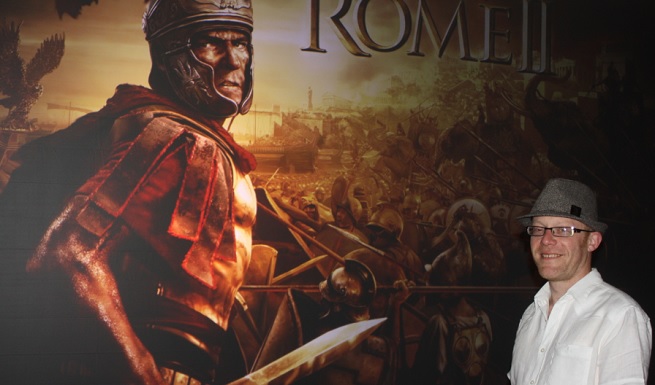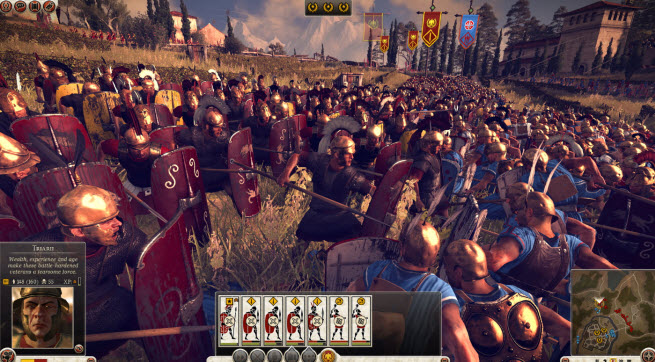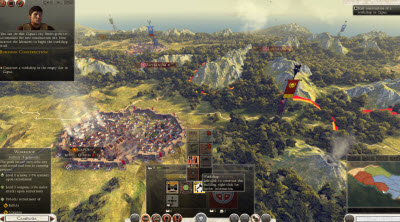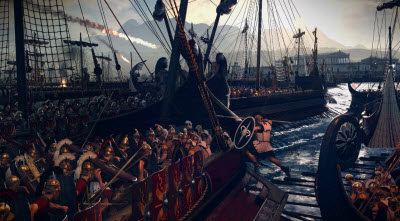GamesBeat: Are you able to fight inside cities now? I remember mostly battling in the fields before.
Bickham: Oh, very much. Siege battles are a big feature in Rome II. Shogun II was very castle-based — it was all about sieges – but we had a limited number of castles. We have a tremendous variety of sizes and shapes of cities here, in different cultural and architectural styles. The variety of city battles is great – everything from tiny settlements up to capital city headshot battles like Carthage or Alexandria, colossal cities with kilometers of high walls and fixed-emplacement onagers and catapults and things like that.
Here’s where we’ve had to do a lot of work with the AI, because we have to teach it how to deal with streets and capture points and line of sight. Going back to the original Rome, we had city battles in that. But what the AI would do is, if it couldn’t defend the walls, it would just pull back to the main square in the center of the city and it would turn into a big mosh pit.
Now the gameplay is more cat-and-mouse, because we have a variable number of capture points in each city. A smaller city might have one. A big city might have three. If you have to capture the majority of points and hold them for a certain period of time, that makes the game different. You have to think about the balance of where you put your forces around the city. You might send some fast-moving units to nip off one capture point, and then send the bulk of your forces to really solidly fight for and hold another point while denying it to the enemy.
GamesBeat: You can go into the soldier’s-eye view now. Is that more fun? Will you notice different things?
Bickham: One of the things we’re trying to do is push at both ends of the scale spectrum. We have this enormous world with so much choice and variety and cultural variance, but right in close, when you use the unit camera, you’ll see the extra detail, a much greater variety of combat animations.
During Rome II, we built our own motion capture studio. Before, we used to rent places out. We had a tiny little space at the office where we could do some limited motion capture. Having our own facility with 56 motion capture cameras trained on up to five guys fighting in the same volume has meant we can just massively increase the amount of animation we put into the game.
We’ve got 700 different unit types, so we need to have relevant matchups going on. A swordsman facing a pikeman – from a phalanx unit, say – they’re going to fight in a very specific way. We need to think about that. When they all run into the phalanx, some of them are just going to run right on to the spears, and you’ll see that in the game when you’re up close. We’re supporting the fact that we’re letting people get up close and have that incredibly cinematic experience.
GamesBeat: One of the things I always have a problem with in Civilization is that there’s too much building. It seems like there isn’t as much of that here.
Bickham: It’s balanced, really. Building is an important part of the game because it’s how you win. You increase the ability of your cities to output more advanced troop types or produce coin to increase your trading power. But it’s not quite the same thing as Civ.
You have those elements, culture-increasing elements. With cities, it’s pretty obvious what all the buildings do. You build a training ground or a barracks, you know it’ll produce troops. For each of those buildings, there’s an upgrade tree. On top of that, most factions each have a unique building type or building chain. If you play as the Spartans, they get to build the Monument to Leonidas. When you see those building options, you want to dig into them, because they bring interesting benefits to your faction. That particular building gives tremendous bonuses to the experience gain of your hoplites, the Spartan warriors.
GamesBeat: Do the various campaigns hold very closely to history? Or are some of these more fictionalized?
Bickham: I would say this of any Total War game. We put the player at a historically accurate starting point. The game starts in 217 B.C., around the time of the Punic Wars – Scipio and Hannibal and all those great battles. It’s an amazing period for drama.
Once the player starts the game, everything becomes counterfactual very quickly. You’re carving out your own empire. You might say, “No, I’ll just trade with Carthage. I’ll take Rome east and conquer the Greeks and hit the Parthians and Persians.” The flow of history changes as soon as the player gets his hand on the tiller.
We always say, if there is too much tension in some part of the game between history and gameplay, then gameplay wins. We’re making a game and a game should be fun to play. So we don’t slavishly follow history, but we remain as authentic as we can. We do an awful lot of research. The unit types and the armor they’re wearing, the fighting styles, those matchups between a spearman and a swordsman or an elephant and a chariot, we look for historical authenticity when we balance the abilities of these things against each other.
Just like any Total War game, you choose a faction to start. You might choose the Gauls or Rome itself or whoever, and you have a geographically authentic starting point. But things quickly change. We aim for authenticity in everything we do, but it’s up to the player to change history as they see fit.
VentureBeat's mission is to be a digital town square for technical decision-makers to gain knowledge about transformative enterprise technology and transact. Learn More




